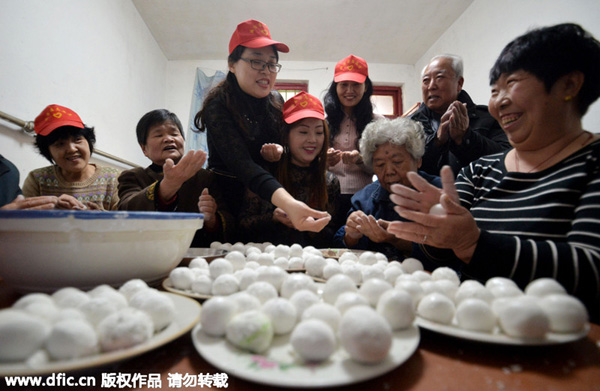Embracing the 'silver economy' with public private partnership
Updated: 2016-05-10 08:14
By HE JINGWEI(China Daily)
|
||||||||
 |
|
Volunteers and empty-nest seniors make Yuan Xiao, a typical food for Lantern Festival, in Handan, Hebei province, March 3, 2015. [Photo/IC] |
The Chinese society is aging at an unprecedented rate. The number of people aged 60 or above reached more than 220 million at the end of 2015, accounting for close to 16 percent of the country's population. The figure is expected to increase to 25 percent by 2030. The elderly population is expected to grow to 500 million, larger than the entire population of the United States, by 2050.
These drastic demographic changes are driven by the declining fertility rate because of the one-child policy and changing social values toward child-bearing, as well as the rising longevity as a result of the general improvement in living standards. The impact of aging on the social service system is profoundly significant.
Unlike Japan, South Korea and other developed countries which were rich enough before the aging of their populations, China is not there yet. China's problem is compounded by the vast regional disparity in household income and the urban-rural divide.
As a Confucian society, old-age support in China has been traditionally reliant on filial piety and family support, which have been unfortunately weakened by the emerging 4-2-1 family structure (4 grandparents, 2 parents and 1 child) and the long physical distance between retired parents and their working children. Worse, the elderly suffer not only from acute illnesses requiring hospitalization but also from chronic disability because of diseases such as dementia, stroke and osteoporosis, which need long-term care that is far more resource-consuming.
The gap between mounting demand for elderly care and the limited capacity of service provision is starkly immense in China.
According to the Ministry of Civil Affairs, China has only 2.1 nursing home beds for every 1,000 elderly, a level far lower than the international standard for lower middle-income countries. Only about 30,000 elderly care institutions have been registered with 5.8 million beds in the country, suggesting enormous unmet demands. Eldercare in China is still in its infancy. Despite the existence of government-funded elderly homes, standards of service tend to be low. More important, the chance of getting admitted is as good as winning a lottery given the extremely long waiting list.
Private facilities have been thriving, mainly in big cities such as Beijing and Shanghai, but expensive costs have denied most senior citizens access. Associated with low occupational prestige, the people working in the eldercare sector are typically lowly educated with inadequate professional training.
These challenges, however, also augur immense opportunities. Catering to the variety of needs of the elderly population, the "silver hair" market has the potential to flourish in China. Some think tanks estimate the Chinese people will spend more than 10 trillion yuan ($1.54 trillion) from 2016 to 2020 on eldercare, with an annual growth rate of about 17 percent. A government report estimates the market could be worth 4 trillion yuan. The development of the silver economy has been, however, largely constrained by the lack of supportive policy framework and limited sources. A few important policy moves have been taken in recent years.
- Global health entering new era: WHO chief
- Brazil's planning minister steps aside after recordings revelation
- Vietnam, US adopt joint statement on advancing comprehensive partnership
- European border closures 'inhumane': UN refugee agency
- Japan's foreign minister calls A-bombings extremely regrettable
- Fukushima impact unprecedented for oceans: US expert

 Stars of Lijiang River: Elderly brothers with white beards
Stars of Lijiang River: Elderly brothers with white beards
 Wealthy Chinese children paying money to learn British manners
Wealthy Chinese children paying money to learn British manners
 Military-style wedding: Fighter jets, grooms in dashing uniforms
Military-style wedding: Fighter jets, grooms in dashing uniforms
 Striking photos around the world: May 16 - May 22
Striking photos around the world: May 16 - May 22
 Robots help elderly in nursing home in east China
Robots help elderly in nursing home in east China
 Hanging in the air: Chongqing holds rescue drill
Hanging in the air: Chongqing holds rescue drill
 2.1-ton tofu finishes in two hours in central China
2.1-ton tofu finishes in two hours in central China
 Six things you may not know about Grain Buds
Six things you may not know about Grain Buds
Most Viewed
Editor's Picks

|

|

|

|

|

|
Today's Top News
Liang avoids jail in shooting death
China's finance minister addresses ratings downgrade
Duke alumni visit Chinese Embassy
Marriott unlikely to top Anbang offer for Starwood: Observers
Chinese biopharma debuts on Nasdaq
What ends Jeb Bush's White House hopes
Investigation for Nicolas's campaign
Will US-ASEAN meeting be good for region?
US Weekly

|

|









